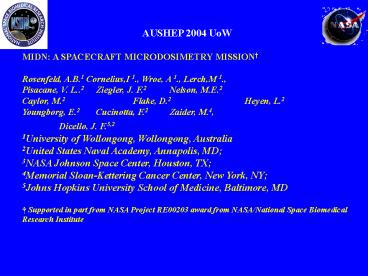AUSHEP 2004 UoW PowerPoint PPT Presentation
1 / 24
Title: AUSHEP 2004 UoW
1
AUSHEP 2004 UoW MIDN A SPACECRAFT
MICRODOSIMETRY MISSION Rosenfeld, A.B.1
Cornelius,I 1., Wroe, A 1., Lerch,M 1.,
Pisacane, V. L..2 Ziegler, J. F.2 Nelson,
M.E.2 Caylor, M.2 Flake, D.2 Heyen,
L.2 Youngborg, E.2 Cucinotta, F.2 Zaider, M.4,
Dicello, J. F.5,2 1University of Wollongong,
Wollongong, Australia 2United States Naval
Academy, Annapolis, MD 3NASA Johnson Space
Center, Houston, TX 4Memorial Sloan-Kettering
Cancer Center, New York, NY 5Johns Hopkins
University School of Medicine, Baltimore, MD
Supported in part from NASA Project RE00203 award
from NASA/National Space Biomedical Research
Institute
2
The most critical health risks, those classified
by NASA as ranked as 1(I), are
- ______________________________________________
- Carcinogenesis caused by radiation
- Loss of bone mass or density
- Human Performance Poor psychosocial adaptation
- Clinical Manifestations Trauma or acute medical
problems - NASAs Critical Path Roadmap (April, 2003)
3
Dicello et al., 2003
4
Dicello and Cucinotta, Encyclopedia of Space
Science and Technology, 2002
5
Space station astronauts take shelter from solar
radiation
Crew retreats to module with more shields during
unusually severe flares
By Frank D. Roylance, Baltimore Sun Staff
Originally published Nov 11, 2000
6
Cucinotta et al
7
RELEVANCE OF PRESENT RESEARCH TO DEVELOP A
SPACE-COMPATIBLE SOLID-STATE MICRODOSIMETRY SYSTEM
- Cancer risks from radiation are almost
universally determined from microdosimetric or
LET spectra. - Present methods for obtaining spectra use either
tissue-equivalent gas proportional counters
(TEPCs) or plastic track detectors. - However, plastic track detectors must be
recovered and processed. The microdosimetric
tissue-equivalent proportional counters in the
NASA Space program have been delicate and
unreliable, and the results have been
inconsistent.
8
OBJECTIVE
- Our goal is to develop a
- rugged,
- compact,
- low-power,
- reliable,
- Solid-state microdosimeter that can measure the
information needed to obtain dose equivalents in
the harsh environments in Space.
9
- NCRP HAS RECOMMENDED THAT RISKS IN SPACE CONTINUE
TO BE STATED IN TERMS OF THE - DOSE EQUIVALENT The product of the physical dose
and the quality factor for a specific type of
radiation (Zaider and Dicello, 2003) - DEQ QF(LTE)D
- or
- DEQ QF(yTE)D
- QF REPRESENTS THE BIOLOGICAL FACTORS
AFFECTING THE RISK AS DEFINED BY ICRU 40 AND ICRP
60 - D REPRESENTS THE PHYSICAL FACTORS AFFECTING THE
RISK.
10
- IN OUR CASE, WE MUST DEVELOP A METHOD FOR GOING
FROM MEASUREMENTS IN SILICON TO RISK IN HUMANS - DEQ QF(ySi)D
- QF REPRESENTS THE BIOLOGICAL FACTORS AFFECTING
THE RISK. - D REPRESENTS THE PHYSICAL FACTORS AFFECTING THE
RISK.
11
Dicello, Wasiolik, and Zaider, IEEE Trans (1991)
12
COMPARISONTEPC and Microdosimeter
I. Cornelius, A. B. Rosenfeld, P. D. Bradley,,
and R. L. Maughan, A Computational Technique for
Simulating Ionization Energy Deposition by
Energetic Ions in Complex Targets, IEEE
Transactions On Nuclear Science, Vol. 47, No. 6,
December 2000
13
- MidSTAR Spacecraft
14
MIDN Locations
15
MidSTAR Configuration
16
MICRODOSIMETER SENSOR
17
IMMEDIATE RESEARCH GOALS
- Ground-based design and development
- Ground-based testing including exposure to
energetic heavy ions (HZEs) at the Brookhaven
National Laboratory - Satellite-based Flight Experiment
- Develop MARS package for NASA Rover mission
18
Microdosimetry Experiments and Simulations
- Shielding for spacecraft and satellites needs to
be developed for extended deployment periods - Biological Effects to personnel need to be
minimised whilst also minimising weight - Shielding can be both theoretically and
experimentally tested using microdosimetry methods
19
Microdosimetry Experiments
- Microdosimetry experiments with the
microdosimeter at different positions within the
phantom gives information of spectra of
secondaries at material boundaries - This provides information for both shielding and
biological materials - Experiments are to be carried out for different
layered heterogeneous structures at LLUMC in 2005
20
Microdosimetry Simulations
- MC simulations once verified provide a powerful
tool for non destructive testing of shielding
configurations - GEANT4 will be used to simulate layered
biological and shielding materials - Studies will help further validate GEANT4
transport algorithms - Spectra of space radiation will be used for the
input for this program
21
Microdosimetry Simulations
22
REMAINING ISSUES
- NEED TO DESIGN AND BUILD A SYSTEM THAT IS SPACE
QUALIFIED, - NEED TO REDUCE THE NOISE TO BE ABLE TO MEASURE
ALL OF THE LOW-ENERGY EVENTS (LOW LET), - NEED TO REDUCE THE DIMENSIONS OF THE INDIVIDUAL
CELLS, - NEED TO DEVELOP METHODS TO GO FROM SPECTRA IN
SILICON TO DOSE EQUIVALENT IN TISSUE.
23
Long-Term Goal
- Determine the risk of cancers for the particles
in Space, in order to more accurately determine
the actual biological risk. - Toward that end, we have been carrying out the
first comprehensive study of the risks of cancers
in animal models that can be best extrapolated to
humans. - We are concurrently carrying out in-vivo studies
of pharmaceutical protectants that can be
administered after exposure to reduce the risks.
24
(No Transcript)

